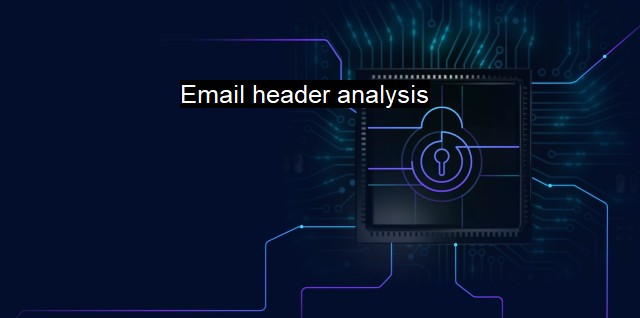What are Email header analysis?
The Importance of Email Header Analysis in Protecting Your Digital Communications: Understanding and Tracing the Origins of Your Emails in the Cyber Age
Email Header Analysis is a vital technique used prominently within the realms of cybersecurity and antivirus protection methodologies. It pertains to the evaluation of email header fields to discover useful information about the origins, pathway, and destination of an email. The primary utility of this processing technique stretches to bridging the security vulnerabilities posed by spam and malicious emails, helping in fortifying the frontline Defence mechanism of an online security infrastructure.An understanding of this concept necessitates a basic insight into the constituents of an email. Broadly, an email is bifurcated into two parts – the body, which contains the essential message, and the header, which strengthens the message with ancillary information. The email header, among other information, includes the sender's and recipient's email addresses, the time of dispatch, and valuable IP information tracing the geographical pathway of the message.
Analyzing the entirety of this information contained in the header forms the foundation of email header analysis. Pertinent software is utilized to break the header's content into individual components and then investigate them. Particular scrutiny is cast on the origination IP data, which may leave footprints as to the legitimate sender of an email.
Within the scope of cybersecurity, email header analysis gains significance as it facilitates the identification of spam or phishing emails. These are often meticulously constructed to counterfeit legitimate communication, misleading and manipulating the user into actions that compromise data integrity and security. As per cybersecurity service providers and antivirus software creators, such fraudulent emails are one of the main sources of malware, deployed to disrupt an individual or organization's digital resources and functions.
The email header contains operational artifacts and trails left behind by the message's sender. Analyzing these artifacts and trails can raise red flags if the email originates from unverifiable or suspicious sources. The IP addresses incorporated into the email header can present invaluable information about the sender's geographical location and the dispatching mail server's identity. This serves to spotlight anomalies, such as incongruity between the actual location and the legitimate IP locations associated with the sender, as do some contemporary phishing attempts.
Email header analysis has proved to be an indispensable tool for antivirus programs trained to sniff out harmful emails based on Make Species-specific marks in the headers. Some may abuse the SMTP protocols, while the others may contain addresses mediating or collaborating the sources. Analysis can expose these disguised source codes and detect the embedded malware before it afflicts the inbox and precipitates towards larger networks. Much like an antivirus scanner delves into individual files, the technique delves into individual headers to obviate probable threats.
Email header analysis demystifies the passage of a dubious email, documenting the chronological timeline across which several servers routed it, eventually cementing the track from the original source to final destination. This is akin to a breadcrumb trail, guiding investigators directly back to the offender's point of origin.
While primary antivirus protection continues to play a major role in digital protection, techniques like email header analysis significantly supplement holistic cybersecurity. Policymakers, cybersecurity strategists, and antivirus software makers are realizing the indispensable role played by this technique in undergirding antivirus protection measures and adopting it more willingly.
Concise and well-executed email header analysis can illuminate hidden moats in the castle of digital communication, detaining dubious messages at the gates before they carry out their damaging intent. They feature as safeguards blended within the larger framework of cybersecurity, echoing the sector's emphasis on preventive and preemptive protection. Email header analysis, therefore, appears poised to remain an integral aspect of the rapidly evolving intersection of cybersecurity and antivirus defenses.

Email header analysis FAQs
What is email header analysis?
Email header analysis is the process of examining the technical details contained in the header of an email message to determine the source and path of the email. It can provide valuable information for cybersecurity and antivirus purposes.Why is email header analysis important for cybersecurity?
Email header analysis is important for cybersecurity because it can help identify and prevent fraudulent or malicious emails. By analyzing the header information, cybersecurity experts can trace the origin of the email and determine if it is a legitimate message or a phishing attempt.What are some key elements to look for in an email header analysis?
Some key elements to look for in an email header analysis include the source IP address, the domain of the sender's email address, the routing information, and the type of authentication used. These details can provide valuable clues about the legitimacy and origin of the email.How can antivirus software use email header analysis to protect against threats?
Antivirus software can use email header analysis to detect and block malicious emails before they reach the recipient's inbox. By analyzing the header information, the software can identify suspicious or unusual behavior and automatically quarantine or delete the email. This can help protect against malware, phishing, and other types of cyber attacks.| | A | | | B | | | C | | | D | | | E | | | F | | | G | | | H | | | I | | | J | | | K | | | L | | | M | |
| | N | | | O | | | P | | | Q | | | R | | | S | | | T | | | U | | | V | | | W | | | X | | | Y | | | Z | |
| | 1 | | | 2 | | | 3 | | | 4 | | | 7 | | | 8 | | |||||||